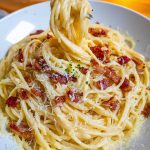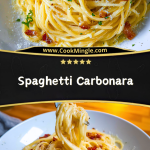I absolutely love making Spaghetti Carbonara—it’s one of those dishes that feels incredibly indulgent, yet it’s surprisingly simple and fast to prepare. Every time I twirl a forkful of those glossy, cheese-laced noodles, I’m reminded of the beauty of a few quality ingredients working in perfect harmony. The crispy pancetta, creamy sauce made without a drop of cream, and sharp kick from Pecorino Romano come together like a dream.

This dish is more than just a go-to for weeknight dinners—it’s my comfort food, my quick-fix when guests drop by unannounced, and my late-night craving all wrapped into one. There’s something soul-satisfying about how the egg-based sauce clings to the hot pasta, and how each bite is both rich and balanced with salt, fat, and a touch of peppery heat.
Why You’ll Love This Spaghetti Carbonara
If you’re looking for a dish that feels fancy but doesn’t require hours in the kitchen, Carbonara is a winner. It’s creamy without cream, hearty without being heavy, and rich with just a few pantry staples. It’s perfect for dinner parties, date nights, or just treating yourself after a long day. And once you get the hang of it, you’ll never settle for anything less than this Roman classic again.
What Kind of Pasta Should I Use for Spaghetti Carbonara?
Traditionally, spaghetti is the star of carbonara, and I stick with it most of the time—it’s ideal for wrapping up that silky egg-and-cheese sauce in every bite. But you’re not locked into just one shape. Bucatini is a great option if you want a bit more chew and sauce retention thanks to its hollow center. Fettuccine and linguine also work well if you enjoy a wider noodle with your sauce. Just be sure to choose a pasta with some structure to it, so it can stand up to the richness.
Options for Substitutions
Pancetta or Guanciale: The classic choice is guanciale, which offers a deep porky richness. Pancetta is an excellent substitute and easier to find. If needed, thick-cut bacon works in a pinch—just choose one that’s not heavily smoked.
Cheese: Pecorino Romano is sharp and salty, perfect for cutting through the richness of the sauce. If unavailable, Parmesan (Parmigiano Reggiano) can step in. It’s milder but still delicious.
Eggs: Use large fresh eggs—some recipes call for yolks only, while others mix whole eggs and yolks for creaminess. I like using 2 yolks and 1 whole egg for a balance of texture and richness.
Pasta Alternatives: Gluten-free pasta or whole wheat versions can be used, just watch the cooking time and be sure to reserve some pasta water for your sauce.
Black Pepper: Freshly cracked black pepper is essential. It adds a spicy edge that really lifts the dish. Avoid pre-ground pepper if you can—it just doesn’t have the same bite.
Ingredients for this Spaghetti Carbonara
Spaghetti
The base of the dish—long, thin strands that hold onto the sauce beautifully. It’s best cooked al dente to give the perfect bite.
Guanciale or Pancetta
This provides the salty, fatty, crispy contrast that balances the creaminess of the sauce. Guanciale is traditional, but pancetta or even good-quality bacon can work.
Egg Yolks and One Whole Egg
The magic of carbonara lies in this combination—no cream needed. The yolks bring richness, while the whole egg gives a silkier finish.
Pecorino Romano
Sharp, salty, and nutty—this cheese melts into the eggs to create that luscious, creamy sauce. Parmesan is an acceptable substitute if necessary.
Freshly Cracked Black Pepper
More than just a seasoning—it’s a defining flavor in carbonara. It adds heat and complexity that balances the richness.
Salt
Used sparingly, mostly to season the pasta water. The cheese and meat bring plenty of salt on their own.
Reserved Pasta Water
A splash of this starchy water helps bring everything together, making the sauce glossy and smooth without breaking.

Step 1
Start by bringing a large pot of salted water to a boil. Add the spaghetti and cook until just al dente. Before draining, scoop out about a cup of the pasta water and set it aside—you’ll need it for the sauce.
Step 2
While the pasta cooks, cut the guanciale or pancetta into small strips or cubes. Place them in a cold skillet and bring it up to medium heat. Let the fat slowly render out until the pieces are golden, crisp, and irresistible. Turn off the heat but keep the rendered fat in the pan.
Step 3
In a mixing bowl, whisk together the egg yolks, whole egg, grated Pecorino Romano, and a generous amount of freshly cracked black pepper. It should form a thick, paste-like consistency.
Step 4
Add the hot, drained spaghetti directly into the skillet with the crispy guanciale (with the heat off to avoid scrambling the eggs). Quickly pour in the egg and cheese mixture, stirring fast and constantly to coat the pasta. Add a splash of reserved pasta water as needed to thin the sauce and make it silky.
Step 5
Toss until everything is evenly coated and the sauce has emulsified—no clumps, no scrambled eggs, just a glossy finish clinging to each strand of pasta. Serve immediately with more cheese and black pepper on top.
How Long to Cook the Spaghetti Carbonara
The entire process takes about 20 minutes from start to finish. The pasta itself needs around 8–10 minutes to reach al dente, while the guanciale crisps up in about 5–7 minutes. Once everything is combined, the sauce comes together in under a minute with the residual heat from the pasta. It’s one of those wonderfully quick recipes that still feels special.
Tips for Perfect Spaghetti Carbonara
- Use Room Temperature Eggs: This helps them blend smoothly into the sauce without seizing up.
- Don’t Overcook the Pasta: Al dente is key; overcooked pasta will break down when tossing with the sauce.
- Kill the Heat Before Mixing Eggs: Always remove the pan from the stove before adding the egg mixture. Heat will scramble your sauce if you’re not careful.
- Reserve Pasta Water Generously: It’s your secret ingredient to adjust the texture of the sauce and get that glossy finish.
- Use Freshly Grated Cheese: Pre-grated cheese doesn’t melt as well and often contains anti-caking agents.
- Work Quickly: The residual heat from the pasta is what cooks the eggs into a sauce—don’t let the noodles cool down too much.
- Season Thoughtfully: Between the salted water, cheese, and pork, taste before you add extra salt.
Watch Out for These Mistakes While Cooking
- Scrambling the Eggs: This happens when the eggs are added to a pan that’s still too hot. Let the pan cool slightly before mixing.
- Skipping the Pasta Water: It’s crucial for achieving that creamy, emulsified sauce. Always save some before draining the pasta.
- Overcooking the Guanciale: Crispy is good, burnt is not. Start in a cold pan and render slowly for the best texture and flavor.
- Adding Cream: Authentic carbonara doesn’t use cream. The sauce should come from eggs, cheese, and pasta water alone.
- Using Pre-Grated Cheese: These often contain additives that prevent smooth melting. Always grate fresh.
- Cooking Pasta Too Early: Timing matters. Aim to have the pasta ready right when the guanciale is crisp and the egg mixture is prepped.
What to Serve With Spaghetti Carbonara?
Garlic Bread
The perfect crunchy, buttery partner to soak up any leftover sauce.
Arugula Salad with Lemon Vinaigrette
Peppery and bright, this salad cuts through the richness of the pasta.
Grilled Asparagus
Light and slightly charred, it adds a fresh green element to the plate.
Roasted Cherry Tomatoes
Their sweetness and acidity balance the saltiness of the dish.
White Wine—Pinot Grigio or Soave
A crisp Italian white wine pairs beautifully with the creamy, cheesy notes.
Sautéed Mushrooms
Earthy flavors complement the savory pork and cheese.
Caprese Salad
Tomatoes, mozzarella, and basil bring a refreshing, cool contrast.
Crispy Prosciutto Chips
Double down on the savory, salty elements for a bit of crunch on the side.
Storage Instructions
Spaghetti Carbonara is best enjoyed fresh, but if you have leftovers, here’s how to keep them tasting good. Store any remaining pasta in an airtight container in the fridge for up to 2 days. When reheating, avoid the microwave—it tends to overcook the eggs and dry things out. Instead, gently reheat in a nonstick pan over low heat with a splash of water or chicken broth to loosen the sauce. Just stir continuously until warmed through. It won’t be quite as silky as fresh, but still comforting and flavorful.
Freezing isn’t recommended, as the egg-based sauce tends to separate and lose its creamy texture once thawed.
Estimated Nutrition
Per serving (based on 4 servings total):
- Calories: ~520 kcal
- Protein: 20g
- Carbohydrates: 50g
- Fat: 26g
- Saturated Fat: 9g
- Cholesterol: 180mg
- Fiber: 2g
- Sodium: 720mg
- Sugar: 2g
These values can vary depending on the exact ingredients and quantities used, but this gives a solid ballpark for one generous plate of carbonara.
Frequently Asked Questions
Can I make carbonara without pork?
Yes, you can substitute with turkey bacon, smoked tofu, or even sautéed mushrooms for a vegetarian take. The flavor will differ, but the creamy essence can still shine.
Is cream ever used in traditional carbonara?
No, authentic Roman carbonara never includes cream. The richness comes solely from egg yolks, cheese, and pasta water.
Why did my sauce turn out scrambled?
That usually means the egg mixture was added to pasta that was too hot. Always take the pan off the heat before mixing in the eggs, and stir vigorously.
Can I use pre-cooked bacon?
You can, but it won’t render fat or get as crispy. It’s better to cook bacon fresh for the right texture and flavor.
How do I reheat leftovers without ruining the sauce?
Use a nonstick skillet over low heat and add a splash of water or broth while stirring continuously to gently bring the sauce back to life.
What kind of cheese is best for carbonara?
Pecorino Romano is the gold standard—salty and sharp. Parmesan is an acceptable substitute, but aim for authentic cheeses for best results.
Can I use whole eggs instead of just yolks?
Yes, though yolks provide the richness. I like to use a mix—usually two yolks and one whole egg—to strike a balance between texture and creaminess.
Is it okay to serve carbonara cold?
It’s safe to eat cold, but not ideal. The texture and flavor are best when freshly made and warm.
Conclusion
Spaghetti Carbonara proves that sometimes, the simplest dishes leave the biggest impression. With just a few core ingredients and careful technique, you get a rich, creamy, savory pasta that tastes like it came from a Roman trattoria. Whether it’s your first time making it or your fiftieth, there’s always something incredibly satisfying about pulling it off just right. It’s classic, comforting, and always hits the spot.

Spaghetti Carbonara
- Total Time: 20 minutes
- Yield: 4 servings
Description
Spaghetti Carbonara is a creamy, indulgent pasta dish made with simple, high-quality ingredients. Crispy guanciale, rich egg yolks, and salty Pecorino Romano create a luxurious sauce that clings to every strand of spaghetti, all without a drop of cream. Perfect for a quick dinner that feels gourmet.
Ingredients
400g spaghetti
150g guanciale or pancetta
2 large egg yolks
1 whole large egg
70g Pecorino Romano, finely grated
1 tsp freshly cracked black pepper
Salt, to taste
1/2 cup reserved pasta water
Instructions
1. Bring a large pot of salted water to a boil and cook the spaghetti until al dente. Reserve 1/2 cup of the pasta water before draining.
2. Cut guanciale or pancetta into strips and place in a cold skillet. Cook over medium heat until crispy and golden. Remove from heat.
3. In a bowl, whisk together egg yolks, whole egg, Pecorino Romano, and black pepper to form a thick paste.
4. Add the hot drained pasta to the pan with guanciale. Remove from heat, then quickly add the egg mixture, stirring constantly.
5. Add reserved pasta water a bit at a time to create a smooth, glossy sauce that coats the pasta.
6. Toss everything together until evenly combined. Serve immediately with extra cheese and pepper.
Notes
Best enjoyed fresh. Store leftovers in an airtight container in the fridge for up to 2 days.
Reheat gently in a pan with a splash of water or broth.
Do not freeze; sauce may separate.
- Prep Time: 10 minutes
- Cook Time: 10 minutes
- Category: Pasta
- Method: Stovetop
- Cuisine: Italian
Nutrition
- Serving Size: 1 plate
- Calories: 520
- Sugar: 2g
- Sodium: 720mg
- Fat: 26g
- Saturated Fat: 9g
- Unsaturated Fat: 14g
- Trans Fat: 0g
- Carbohydrates: 50g
- Fiber: 2g
- Protein: 20g
- Cholesterol: 180mg

